Tuesday 31st May 2022

TfL are set to announce further major cuts to its central London bus network today with speculation mounting they’ll include the withdrawal of some iconic routes including low numbered jewels 11, 12, 14, 16 and 24. Of course these may just be scurrilous rumours as the Mayor and TfL negotiate future funding with the Department for Transport with the current ‘temporary’ deal running out in just over three weeks time on 24th June. My guess on that is there’ll be yet another eleventh hour roll over to buy more time, particularly to assess how the recently opened Elizabeth line is impacting finances. But that doesn’t mean central London’s bus routes are safe. Far from it.
As my London Bus Cuts Tracker page shows, London’s bus passengers have been suffering a steady drip drip reduction in frequencies over the last couple of years such that the number of buses required to run the capital’s network at the end of 2016 at 8,145 had reduced by around 300 buses by the end of 2018 (to 7,850 buses) and since then has reduced by roughly another 350 buses to around 7,500 representing a cut of 8% during this time.
This reduction is nowhere near enough to turn the finances around and further reductions in central London bus routes are needed to ensure the unsustainable financial losses are stemmed by reducing the miles operated.
If the speculation on the list of routes to be withdrawn is correct, with others being talked about including routes 4, 31 and 74, it will lead to howls of protest to see such beloved routes fall off the metaphorical bus map (not that there is a bus map, of course), as happened when route 13 was proposed for withdrawal in 2017 resulting in a huge public campaign to retain it. In the event, it was withdrawn but in a sleight of hand TfL renumbered parallel route 82 to become route 13 thus pretending it hadn’t been withdrawn after all, but the 82 had (it hadn’t).
The same trick could be pulled again as it’s almost certain some of the routes speculated for withdrawal will see other parallel running routes extended to cover isolated sections of the withdrawn routes – eg the section of route 24 between Victoria and Pimlico would otherwise be left without a bus. The idea of withdrawing complete routes enables frequency reductions to be achieved along formerly busy corridors where other routes parallel these long established icons. But the problem for TfL is they need to go through the rigmarole of a full public consultation process if a whole route and its route number disappears whereas the drip drip cuts over the last couple of years haven’t had to be scrutinised as they’ve been just frequency reductions rather than route withdrawals.
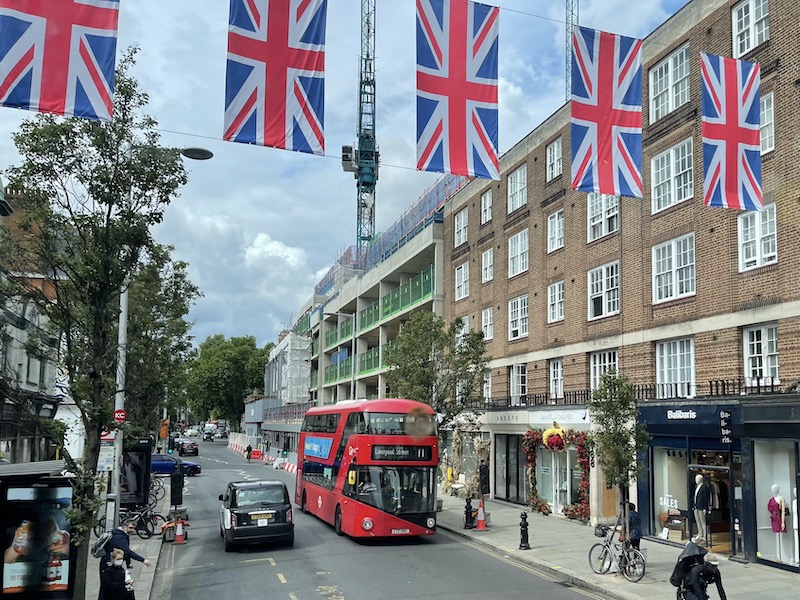
The full consultation works had to be used for the proposed withdrawal a few months ago of route 271 between Moorgate and Highgate Village even though the only small isolated section of route will be covered by a diversion of route 21 to Holloway as explained in a previous post. A similar situation arose with route 168 (and route 1). Neither of these proposals have yet been implemented and no dates have been announced.
As we know, once TfL’s public consultation process is invoked it can take years to bring anything to fruition. Take the changes proposed for bus routes in the Croydon and Sutton area for example. These were consulted on between October and December in 2020. A report on the responses received was published in September 2021 yet the majority of the changes have still not been introduced and I did hear may not be implemented before 2024 due to contractual implications with the bus operators running the routes for TfL. Such are the delights of franchising. Never mind whether some of the changes might be beneficial for passengers; it could be four years to wait.
This isn’t the first time route 11 has featured as a possible candidate for the chop. Back in 2018 TfL consulted on proposals to partly replace it between Fulham Broadway and Victoria with a new route 311 running from Fulham to Oxford Circus which would also have seen changes to routes 19 and 22. In the event this change didn’t proceed. Route 11 gained a reprieve, but has its time finally come?
It’s against this background I took a ride on London’s two highest profile routes yesterday to see whether the withdrawal speculation is well founded by taking a check on how many people are travelling and how feasible it would be to withdraw or partly replace them and make savings.

First up on my itinerary was route 11, perhaps the most famous London bus route of all. It’s often regarded as a tourist bus route linking the City from its Liverpool Street terminus then taking in Bank, St Paul’s Cathedral, Fleet Street, Aldwych, The Strand, Trafalgar Square, Whitehall, Westminster, Victoria and Chelsea to Fulham. A real feast of tourist vistas for just a £1.65 bus fare.
Route 11 takes 18 buses to provide a 12 minute frequency at a tortuously slow average speed of around 5 mph along the seven miles from Liverpool Street to Fulham.
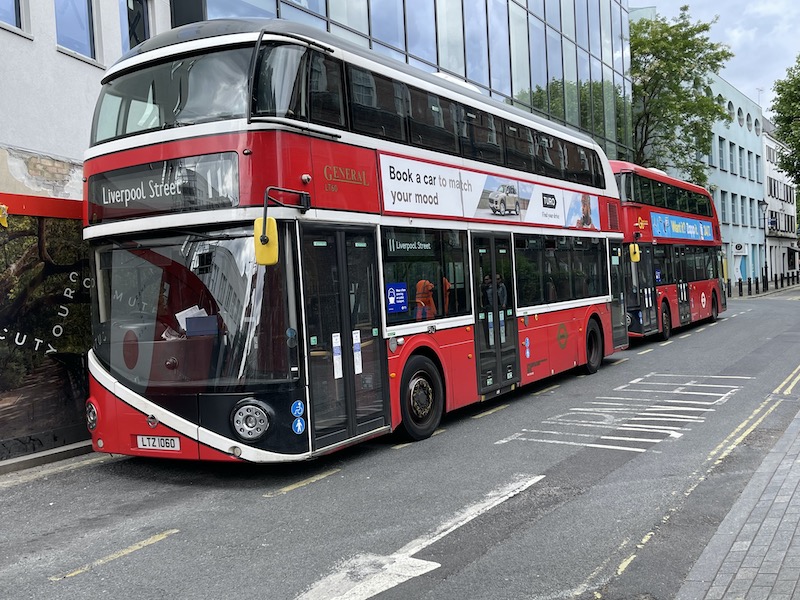
And as I found on my sample journey yesterday morning, the 10:18 from Liverpool Street, it’s the interminable traffic lights that kill any perception you’re making progress as well as the snail like speed when actually moving. I doubt we ever got out of second gear (if the bus still had ‘gears’). I timed every occasion we spent waiting at traffic lights and other obstructions throughout the 75 minute end to end journey (it’s actually scheduled for an even slower 92 minutes). Total traffic light stops came to 22 minutes and 54 seconds. That’s pretty much thirty per cent of the actual journey time spent stationary, and that’s not including time spent at bus stops.
There weren’t many out of the ordinary delays either – only an awkwardly parked white van in Threadneedle Street (which our driver gingerly crept by) ….

…. and some temporary traffic lights in Chelsea which didn’t cause too much of a delay.
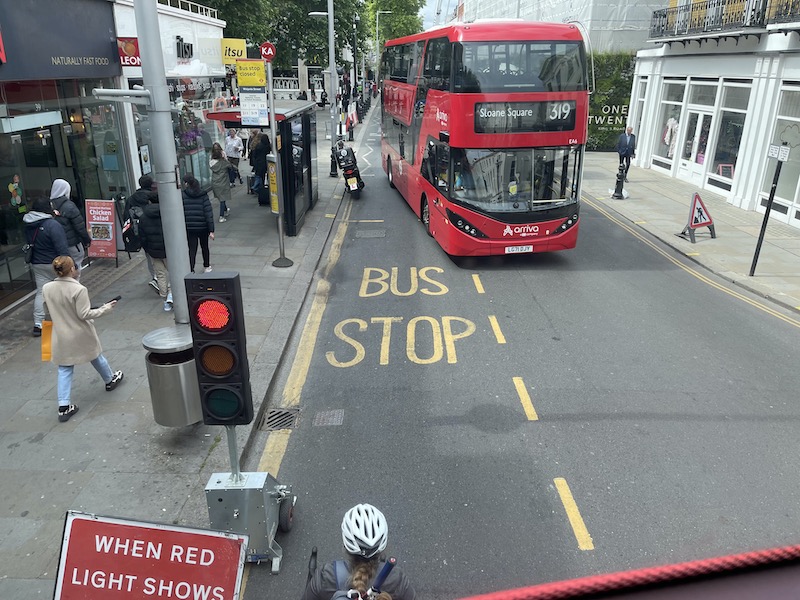
We stopped at about 25 bus stops on the journey and picked up 54 passengers in total with around a dozen on board at any one time – which by observations of buses passing in the other direction was probably busier than the average occupancy.
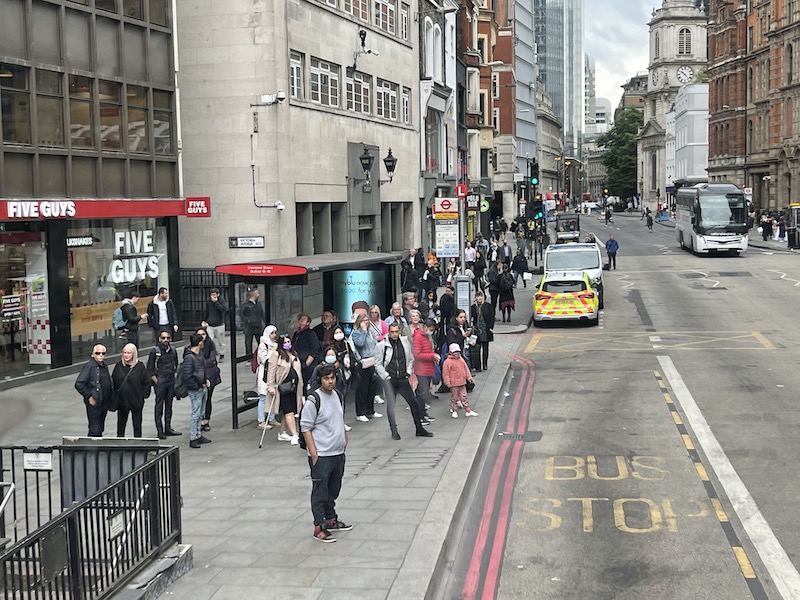
The busiest section of route was between Liverpool Street and Trafalgar Square helped by a couple of family groups of five people each doing the sightseeing touristy bit. Numbers dropped off between Chelsea and the terminus at Fulham with only three left on board when we arrived at the Town Hall terminus bus stop.
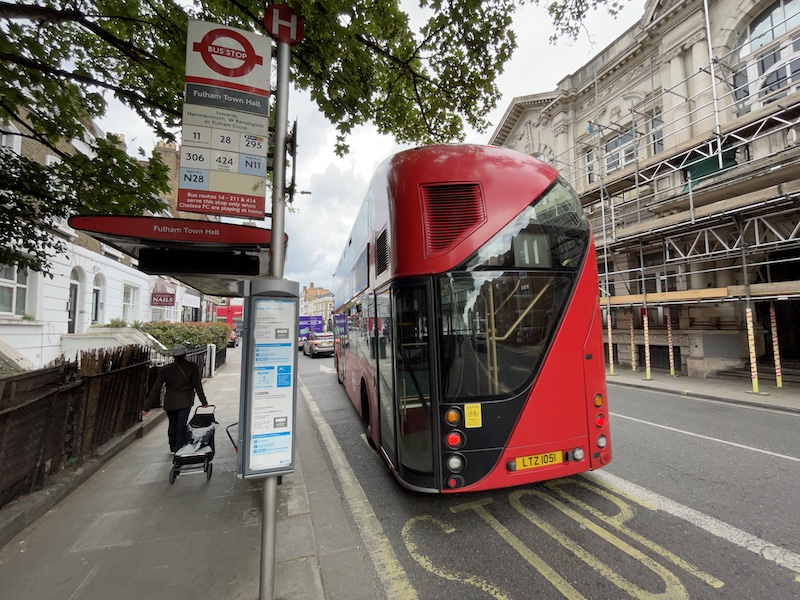
The big downer came as we turned the corner at Victoria station into Buckingham Palace Road and on came the pre-recorded message on the PA and visual display “the final destination of this bus has changed. Please listen for more details”.

That was odd, I thought, as although we’d been making slow progress we were well in line with the schedule, in fact by my reckoning we were well ahead of it, at least 12 minutes early, such is the generous running time on the route. As we approached Victoria Coach Station the driver made another announcement with the promised “details” telling us “this bus will terminate at the next stop” but more positively added “please board the bus in front”.
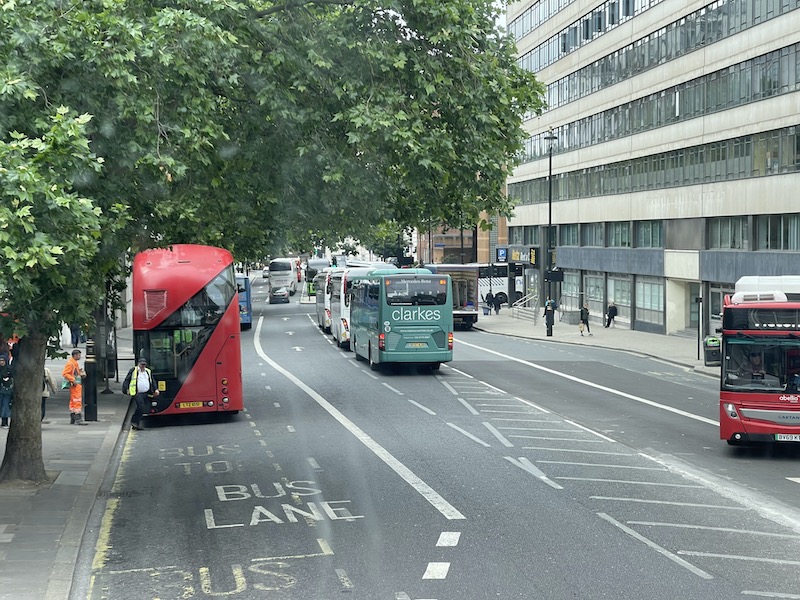
Which was a relief as that bus was waiting for us and the eight of us on board made a quick transition and it only caused us a two minute delay.
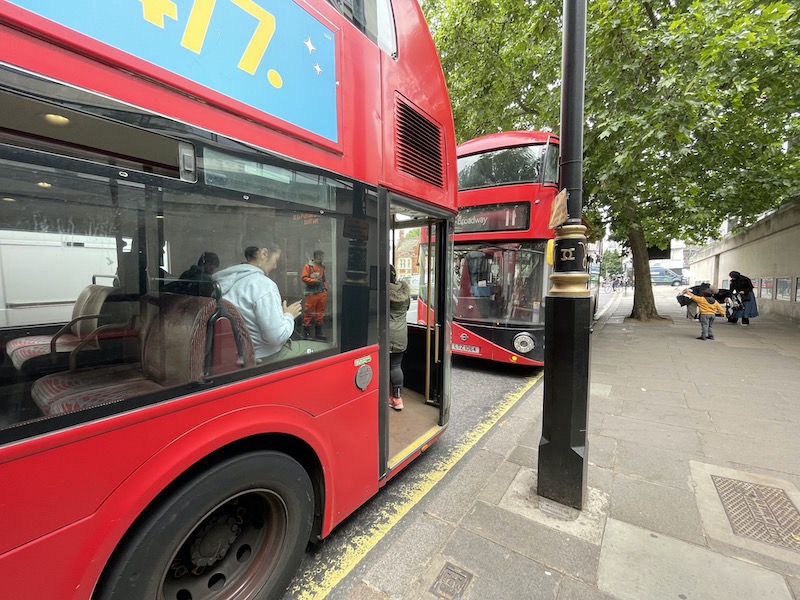
No explanation was given of why our bus was being “terminated” and it was strange we’d caught up the bus in front having travelled so slowly. I knew it was the bus in front as I’d seen it leave Liverpool Street 12 minutes before us.
I’m now left wondering if this is a way of keeping buses to time if the excessive running time is not needed if the roads aren’t to their usual grid locked standard. Hold buses at a point mid route for the bus behind to catch up and transfer its passengers while it, in turn waits for the bus behind – is this a thing on route 11?
The other downer, which could well be one of the many reasons why numbers of passengers on route 11 are not what they once were, is the incorrect and misleading information on display at Liverpool Street Station bus station.
I highlighted in a recent blog the disgraceful out of date (over eight years) ‘where to catch your bus’ poster at Liverpool Street bus station.
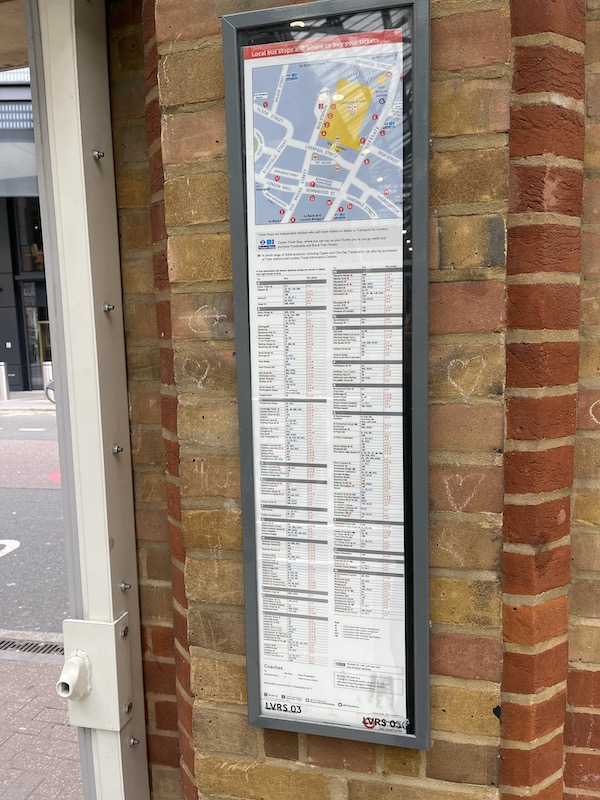
This tells you route 11 to Fulham Broadway leaves from that point (stop C) ….
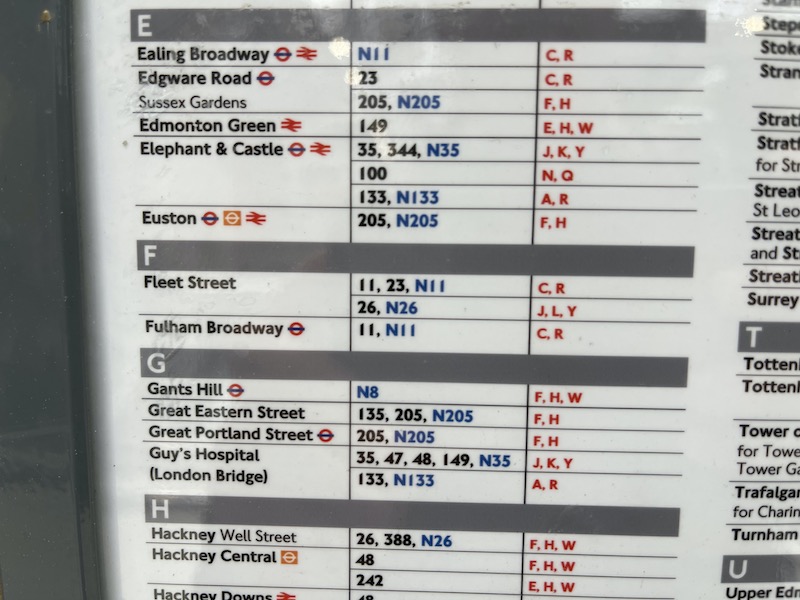
… and stop R in Old Broad Street.
It doesn’t, and hasn’t done since 2019 when it swapped places with route 344.

Route 11 now picks up in Bishopsgate at Primrose Street, the other side of the station. At least the bus stop flag there has been updated with a number 11 plate …
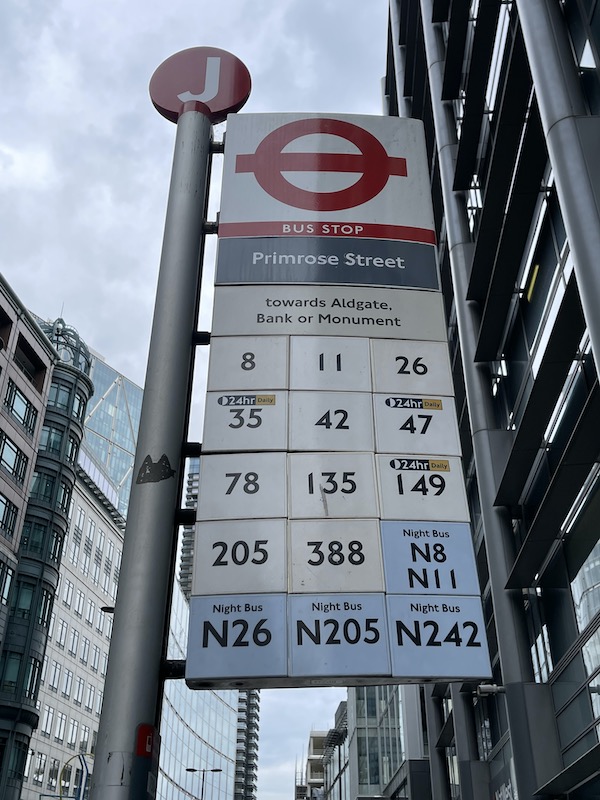
…. but unsurprisingly the timetable case below still shows route 344 departing (it doesn’t) and no reference to route 11 (it does). I suppose on the plus side the graffiti and general dirt on the plastic cover obscures the out of date reference to route 344.

The other case showed a smarter looking diagram for other routes using the stop, but still no reference to route 11, and out of date information about buses on diversion.
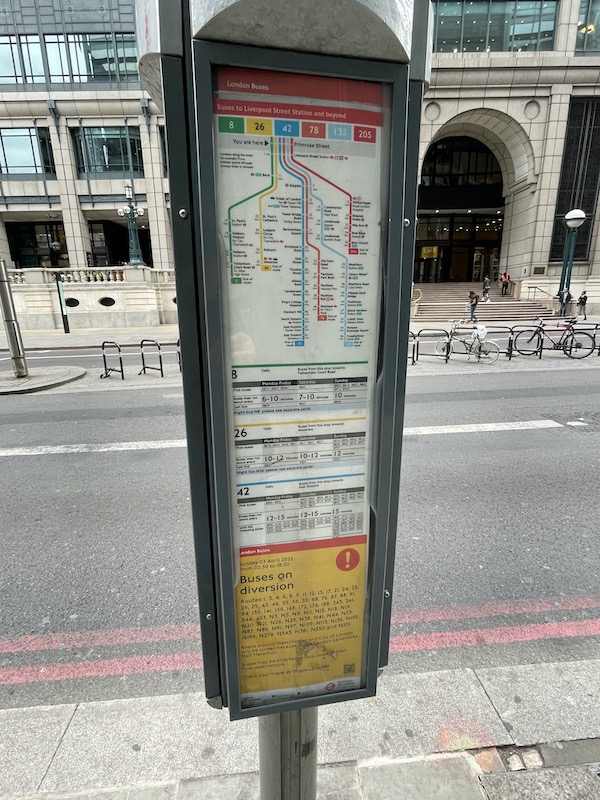
On a positive note I did find an updated spider map from 2019 correectly showing route 11 departing from Bishopsgate (Stops J, L and Y) ….
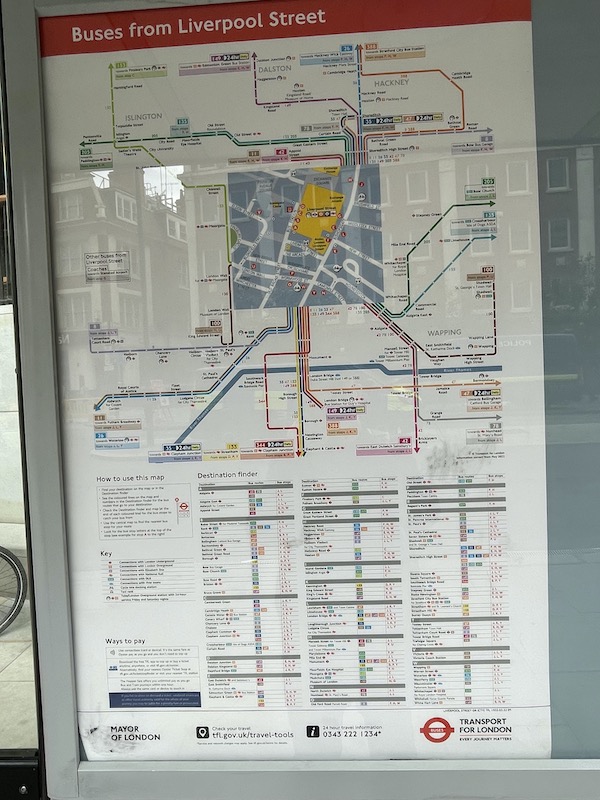
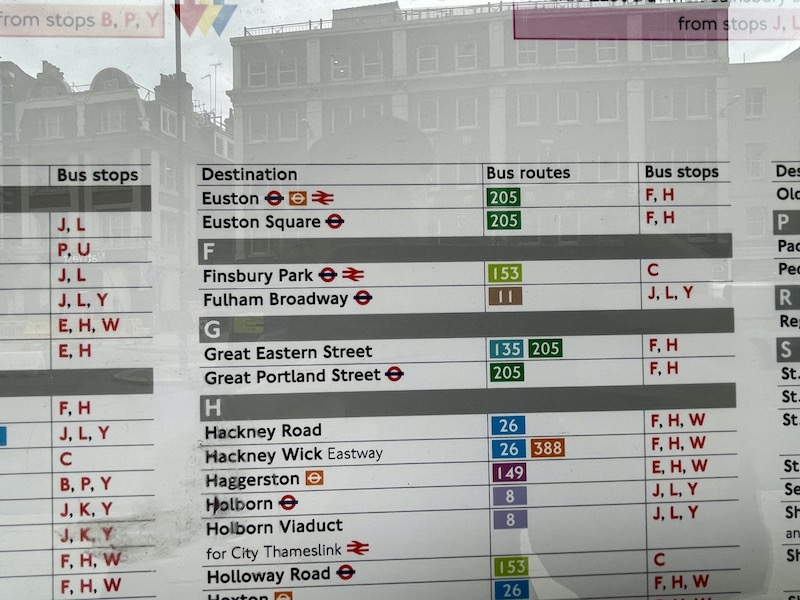
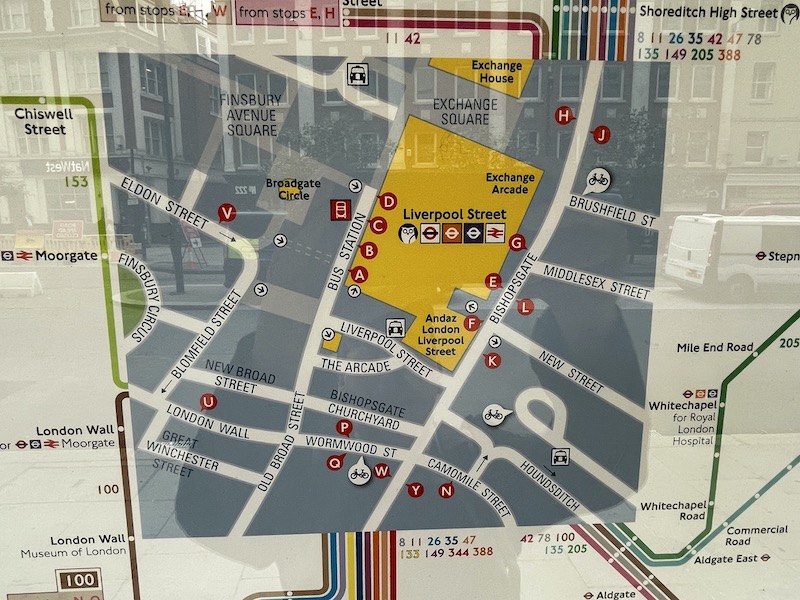
…. but this was displayed in an isolated disused bus shelter on the northbound side of Bishopsgate, not at the southbound bus stop in use.
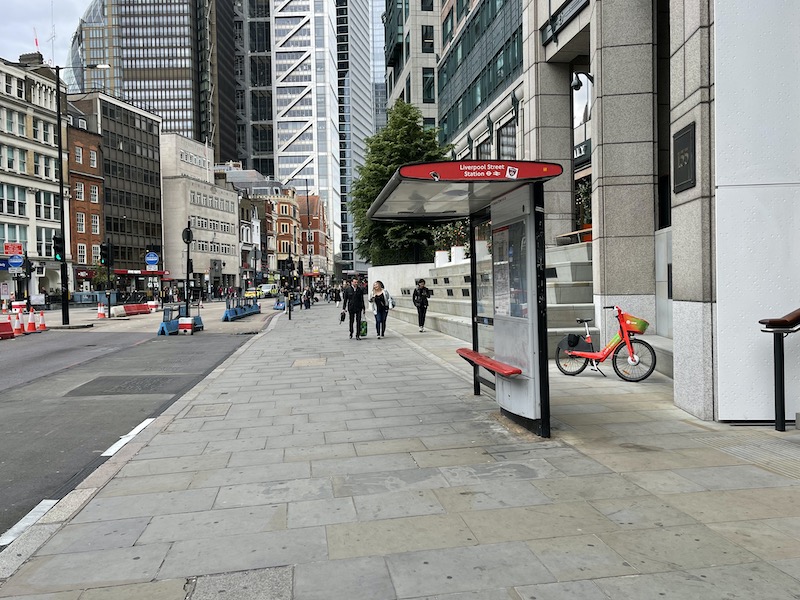
What a shambolic way to run a bus network.
Two and a half years on and incorrect information still on display at a busy central London terminal point, while correct information is displayed in a shelter no longer in use.
And take a closer look at that smart bus in heritage livery at the Fulham terminus shown earlier. The advert on the side is for a car hire/sharing website called Turo. ‘Don’t travel by bus … use a car instead’. What an own goal.

No wonder passengers are deserting central London’s buses. And now more buses are set to be deserting the remaining passengers still travelling.
Is it feasible to withdraw route 11? What might TfL be proposing to replace it with? Based on my travelling experience I would suggest it could be culled in its entirety without any replacement at all. Route 26 parallels it from Liverpool Street as far as Aldwych from where many routes continue along The Strand to Trafalgar Square from where route 24 parallels the 11 to Victoria and route 211 from there to Chelsea and then routes 22 and finally the 28 and two other routes to Fulham. From my observations yesterday morning, buses on all these routes have sufficient capacity to absorb the numbers of passengers using route 11. No road is exclusively served by route 11 so with the hopper fare, it can be argued there’ll be no problem for alternative travel options as has also been done in previous route withdrawals. I doubt many passenger journeys overlap some of the interchange points I’ve listed, except perhaps Trafalgar Square.
However, if the speculation about route 24 also facing the chop is true that’ll blow a hole in the alternative for route 11 down Whitehall beyond Trafalgar Square anyway.

So I also took a ride on route 24 yesterday lunch time between Pimlico and Hampstead Heath to see if that route could similarly be culled. And no, I don’t think it could without some replacements but I reckon a couple of judicious extensions of two other routes would sort that.
Route 27 parallels the 24 northwards from Warren Street to its terminus at Chalk Farm so could easily extend from there on to Hampstead Heath instead of the 24 and route 29 could be extended southwards from its Trafalgar Square terminus to Pimlico. If you wanted to be generous to any cross Trafalgar Square passengers you could extend route 15 (which also parallels route 11 from Mansion House) from its terminus at Trafalgar Square to say, Victoria.

The only complication with this plan is route 29 runs more frequently than the 24 and would provide too much capacity but this is easily resolved by TfL finally being realistic and ceasing its restrictive operating practice of insisting all routes run from end to end. If so, it could extend every other journey on route 29 beyond Trafalgar Square to Pimlico and the problem of over capacity is solved. Alternatively forget route 29 and extend route 15 all the way on to Pimlico, albeit that would then leave any passengers on the 24 crossing Trafalgar Square without a through bus but the old hopper fare is always the answer to such conundrums even if passengers don’t like having to change buses.
Route 24 like the 11 is also seven miles long but it runs more frequently and achieves a higher average speed. It takes 16 buses to run the timetable.
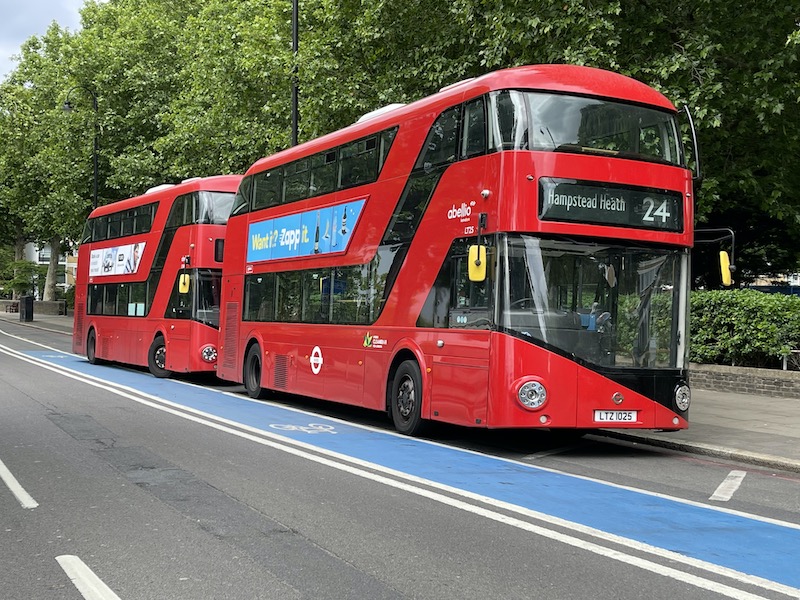
I caught the 12:50 from Pimlico’s Grosvenor Road. It left with two on board and during the 65 minute journey to Hampstead Heath we picked up 82 passengers at 26 bus stops. As well as being busier than route 11 it really was noticeably quicker with only 15 and a quarter minutes spent at traffic lights throughout the journey (that’s 23% of the journey time instead of 30%} with the biggest delays at Parliament Square (six minutes) and Trafalgar Square (four minutes). If you could eliminate those delays it really would be going places.
The most popular bus stop was at the bottom end of Whitehall with 12 boarding – probably influenced by a rain shower commencing just at that moment. Ten passengers boarded at Camden Town making it the next busiest stop. The section of route between Tottenham Court Road and Camden Town was the quietest; this is also covered by route 29 and the Northern line.

Seven passengers alighted at the terminus at Hampstead Heath.
Route 24 runs every 10 minutes during the day and every eight minutes in the morning peak. Unfortunately you won’t know that from the useless bus stop information at the Hampstead Heath terminus….

… because there isn’t any.
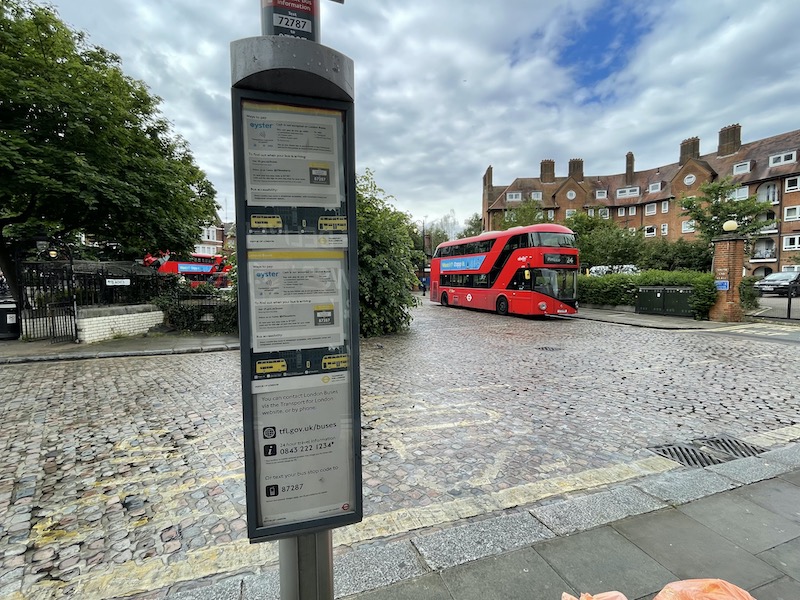
But at least there’s a spider map in the bus shelter.

You could squeeze out half or dozen or more buses by my suggested 24/27/29/(or 15) plan but it will be heresy for traditionalists as route 24 is the longest unaltered London bus route (except for one-way road systems) having continuously linked Hampstead Heath with Pimlico for over 90 years.
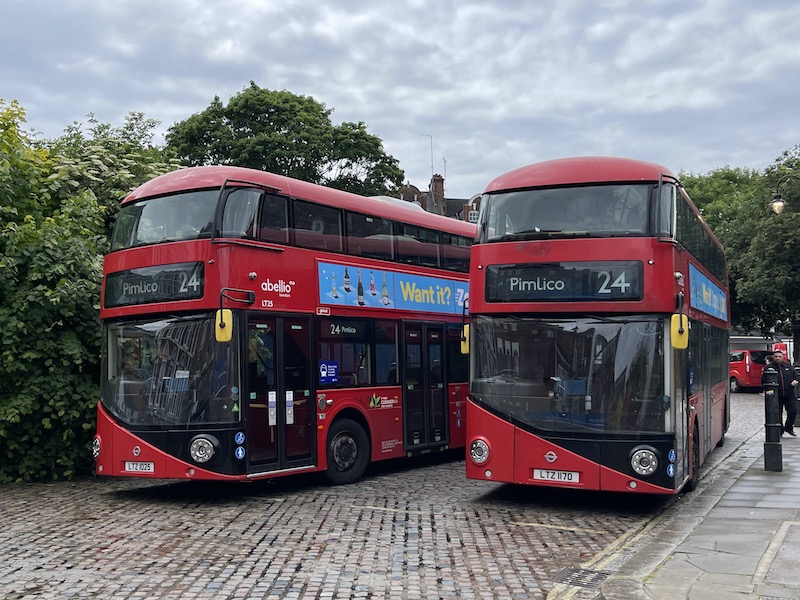
But nostalgia doesn’t fund TfL’s burgeoning deficit. In the absence of any coherent plans to encourage passenger growth (bus maps and displaying updated and correct information would be a start) the only alternative is to continue London’s downward spiral of frequency cuts and route withdrawals reflecting declining passenger numbers which in turn will lead to further frequency reductions, reduced passenger numbers and more frequency cuts. And so it will go on.
By the time you read this, TfL’s promised consultation is likely to have been published today and you’ll know the extent of the proposed cuts, rather than my speculation.
I hope Metro Mayors wanting “London style buses” in their fiefdoms are taking note.
And by the way, that £1.65 fare is unsustainable.

Roger French
Blogging timetable: 06:00 TThSSu

Many thanks for your exhaustive report on these routes, and the trouble you have taken to publicise the failings – TfL owe you a big debt of gratitude (though they ought to be sorting out the publicity failures etc. themselves without external prompting).
Thinking outside the box for a minute (as TfL – and many other bus operators – appear not to do): cuts are easy – you just do them! More profitable – in all senses of the word – would be to get much higher service frequencies from the buses you have; average 5 mph for the 11 is appalling, and every 12 minutes is not good. What happened to bus-prompted traffic lights? – the idea was around in the 1980s!
Is no one researching reducing boarding time? In Stara Zagora, Bulgaria (where I am at present), the buses (and trolleybuses – hoorah) have 3 doors, conductors, simple flat fares, on-board vending machines – AND they often take only a few seconds at stops.
Publicity – as you say – is often poor and out of date. Just make the system like the Underground: frequent services mean timetables are virtually irrelevant. Way-finding signs are B I G and clear. And KEEP PUBLICITY UP TO DATE.
Though you had little trouble with road works, they can be the bane of bus-travellers. Start a national crusade to make firms that dig up the street etc. pay a fee, which can be used to publicise alternative routes for car drivers (to keep them out of the way) and provide extra buses to keep up the frequency if still necessary.
I don’t see why franchising per se should mean delays in changes for the better; maybe it’s the people who need carrots/sticks to get whatever system working better.
Please keep up the good work…
LikeLiked by 2 people
The 24 is the oldest Bus route in London but not the Oldest route in London The 271 goes back to 1914 as a tram route
LikeLike
I think the W7 goes back to 1914 too, though it’s been renumbered at least twice.
LikeLike
Presumably the TfL Director of Busrs thinks lack of information and slow journey times will achieve her aim of
“London’s bus network being crucial to supporting the city’s economy and reducing the capital’s emissions.”
https://tfl.gov.uk/info-for/media/press-releases/2021/july/louise-cheeseman-appointed-director-of-buses
LikeLike
I would ban everything except essential traffic in Central London. That would include cycles that would allow for buses to be sped up. Some of the congestion was self inflicted by TfL from putting on to many buses
Routes also need to be longer. Most have been shortened to the point that they have little purposes. Many bus routes used to be useful for journeys not easily carried out by rail particularly in outer London. Now you probably use the car for those journeys
TfL always used to operate many routes in sections. The 279 originally run in three sections. Hammond St to Manor House, Waltham Cross to Manor House & Waltham Cross to Smithfield
The Hammond St to Waltham Cross became a bit of a fiasco in the early days of route tendering. The first TfL routes to go out to tender were those that ran outside of London so the “7( Waltham Cross to Manor House section went to tender. The tender was one by Eastern National. They were unable to take the tender up initially so TfL carried on with it for a while but they then gave it up and London Country stepped in for a while. Whilst they were operating it they registered the Waltham Cross to Hammond Street Monday to Saturday service as a commercial service
When Eastern Nation took it up it was only operating it between Waltham Cross and Manor House except on Sundays. Even stranger was it was given the route number 359
LikeLike
Two thoughts.
1. I’m not keen on running services in sections, especially if it means paying twice. We used to live at the outer end of the London 94 route and my wife, on her way home from school, used to despair at the number of buses which turned round at Shepherds Bus Garage rather than continuing to Acton Green. We used to joke that the garage must contain a huge magnet which sucked buses in .. but it wasn’t funny on a cold damp winter evening. My son, too, travelling to College was sometimes frustrated by the 207 running in two overlapping sections although his destination was fortunately at the end of the “inner” section.
2. Boarding times: London is great for getting on and off buses, especially where Oyster cards are used. Here in Cardiff – and in many other places – Ticketer machines are used and several fares are offered. It can take some time for the driver to tap the details into his pad and the debit card to be zapped. The cash farebox is quicker (they don’t give change) as are mobile phones – although people have a habit of not calling up the relevant app until they’re actually on the bus. Can’t they see it coming? (Oh, and we don’t have exit doors either).
LikeLike
I agree with your first point: the same thing used to happen with the 16 to Neasden where nearly every bus from Victoria terminated at Cricklewood garage (the present terminus) rather than continuing via Crest Road as I wanted it to.
LikeLike
The current process for changing services in London is far to slow by the time they implement changes the situation could have changed considerably
TfL should look at the services as a network as well rather than just individual routes. With the Oyster card they must have a lot of data on travel patterns tat could be used to update the network
LikeLike
TfL do have comprehensive data on Underground and Overground usage, as all entries and exits are recorded, but for buses, all Oyster gives you is where people board. TfL therefore have absolutely no idea how many people are travelling, say, across Trafalgar Square or Victoria and would be inconvenienced if the 11 were in fact to be withdrawn. It’s all very well saying Hopper fares address this, but with many routes operating reduced frequencies it just makes bus travel even less attractive.
LikeLike
Many young have no knowledge of routes any more, nor do tourists, which is why maps are essential and they must be widely distributed too. Hence tourists no longer use the 11
LikeLike
Bus cuts in London (and other places too) and Vladimir Putin storming through the Donbas but don’t worry Sir Boris Johnson has his priorities bringing back Imperial measurements!
LikeLike
Roger, perhaps you need to sign up the “metro mayors” to your blog and comments about wanting “London style buses”. With the added warning “be careful what you wish for”.
LikeLike
Don’t forget that VCS is the driver relief point, as in all routes that run on headway the relief point mid route causes massive headaches as a time has to be in place for the relief. If there’s no traffic as happened to you buses can run excessively early up to that point and everything else around it has to be told to hold back too!
Excellent article by the way. I shall be sad to see one of my old routes (the 521) go, such a busy route in the peaks pre pandemic.
LikeLike
Traffic light priority, more bus only roads/bus lanes, would reduce running times enabling TfL to reduce the number of buses but maintain frequency, improving their finances.
Compulsory field trip to Zurich needed by TfL managers.
LikeLike
Such a shame if the 24 were to get the chop. When the Elizabeth line’s sections are joined up my plan is / was to travel from West London to TCR and then take the 24 to Victoria Street. TfL giveth and TfL taketh away…
LikeLike
A good discussion and I thought I would raise a few points.
Firstly bus priority at traffic lights is not easy in central London. There are many junctions where buses cross and there is quite a low threshold for hurry calls. Added to this is the needs of cyclists who are seen as more important than bus users by many politicians.
The knowledge of travel patterns that TfL have will be good. Knowing the number of users boarding will be a good proxy for the numbers alighting in the opposite direction. Anomalies can arise with topography etc but these can be picked up with occasional surveys.
Finally many Metro mayors would still welcome the reduced levels of service being offered by TfL. Another advantage is the single hop fare between buses without a fare penalty is rare in the rest of the country. Unsure as to whether those same mayors would want to be the face of service cuts. Andy Burnham’s about turn on the GM low emission zone is an example of reality in politics.
LikeLike
The answer to everything is just increase the bus fares. No exceptions. I bet there aren’t any complainers who can’t afford it!
LikeLike
As a bus trip anorak I no longer enjoy a London day out – “the bus will wait here to even out the service” and “the destination of this bus has changed” dreaded announcements are used far too often, even on very low frequency routes like the 492 – drivers appear happy to dawdle excessively, get a “turn” and then dump their passengers and speed off “not in service” (whilst ibus is NOT changed, thereby fiddling the monitoring system and TFL won’t know/don’t care as there are no “inspectors” anymore)….
It’s all going horribly wrong and nobody in charge cares.. how can the 11 schedule be allowed to have got SO slack that buses can run 12 mins early even having wasted over 20 mins waiting at traffic lights?? That can’t have been some freak “no traffic” day Roger experienced can it? Why doesn’t somebody DO something about it before EVERYONE gives up on the service?!?!?!?
I take my bus trip days in places like Reading or Brighton more these days.. they still have their issues but clearly the ethos is more about providing a useful service to passengers and less about taking the p*** all round like it now is in London.
LikeLiked by 2 people
TfL should know the exact position of every bus on a route so controlling it should be relatively easy. Computers are good at that sort of thing. You can reduce the stand time considerably and just say maintain a 10 minute frequency (Perhaps not quite that simple as they will need to get the drivers in the right place for their breaks etc)
LikeLike
The slackness of many London schedules, the 11 seemingly the very worst (many journeys given almost thirty minutes to get from Victoria Coach station to Trafalgar Square achievable in the same time as walking!), highlights most of TfL’s problems. Themselves! Given the quality of answers to several helpful suggestions made over the years to both improve service provision at lower costs normally have show a total lack of understanding of how to run an efficient bus service as seen in the rest of the UK. They are so wrapped up in “processes”, iron-clad contracts (except when it suits!), worst-case scheduling and clearly inexperienced staff, they cannot see how some of the simplest service changes could benefit both passengers and their finances.
Let us hope those so keen on franchising in other parts of the UK do at least recruit people who understand how buses work.
LikeLiked by 2 people
The 11 at one time had a PVR of 80
The 12 92
The 14 77
The 24 30
LikeLike
To be fair, the 11, 14 and notably the 12 used to be quite a bit longer than now.
LikeLike
TfL have released the consultation on the review of Bus services in London. I have not gone through it all but it looks like a total review of nearly all the bus service that run in central London including ones that run into Central London from Outer London
https://haveyoursay.tfl.gov.uk/busreview
LikeLike
Well, it’s only a few small tweaks everyone….
…”We propose to withdraw the following bus routes:
4, 11, 12*, 14*, 16, 24*, 31, 45, 72, 74, 78, 242, 259, 521, C3, D7, N11, N16, N31, N72, N74, and N242 (*24 hour routes)”
Just these 16 routes, round some local backwaters probably.. they wouldn’t mess with any major familiar trunk routes that have been around for decades now, would they……. Would they..?
It REALLY seems like they just don’t care and have SERIOUSLY lost the plot this time!!
LikeLike
The 259 remains but i being extended from Edmonton Green to Ponders End and will terminate at the Nag Head Holloway rather than Kings Cross
The 279 is being diverted to Stamford Hill. The 349 is Withdrawn
LikeLike
I would have thought it would make more sense to take the 259 to Stamford Hill and extend the 279 to Nags head
LikeLike
I just copied and pasted the headline list TFL provided in the opening page… so they can’t even get THAT right… what hope is there?! 🤦♂️
LikeLike
Well which one is right. I would assume the detailed one but who knows
I have also realised what I suggested means the 349 stays and the 259 is axed with the 279 extended to the Nags Head. If that means to many buses to the Nags Head they could just externed some of them to there
Doing it that way the only change is the loss of the Nags Head to Kings Cross section. There are at least 3 routes that go from the Nags Head to Kings Cross
Doing it as above maintains the Waltham Cross to Manor house Service
I would suspect more demand to go from Waltham Cross to Manor house then to Stamford Hill. There has never been a direct service from Waltham Cross to Stamford Hill at least for decades. It also mean the 279 provided a connection to the many routes that run through the Nags Head
LikeLike
There may be more errors
Looking at the Document called Possible Changes to Routes into Central London
It shows on page 6 the 259 being Withdrawn and on page 10 the 349 being changed
When you look at page 16 it says the 349 is withdrawn and the 259 Changed
So even within that document it is not consistent.
LikeLike
Is it beyond the boffins at TfL to interwork service in order to save resource?
LikeLike
Yes!
As are….
running some/every other journey only part way along the route, to concentrate resources on the end that is used most whilst still allowing other passengers to stay on to get to the lesser used bit without changing,
Also publishing proper timetables, providing network or route maps, updating out of date info at bus stops, making any attempt to make sure their contractors are providing the service that they are supposed to including making sure passengers tap on properly when they get on, encouraging speeding up ANY bus schedules rather than encouraging excess padding and appearing not to put in clauses to contracts to be able to make any changes to anything at all for 7 years!! There’s just a few for starters…..
LikeLike
Hopper fares just make travelling on bus impractical and time consuming. Anyone with mobility issues or travelling with children in buggy’s or shopping bags will be seriously affected.
Buses as an essential public service seems to have been forgotten. As have the lives of those who use and rely on them.
LikeLike
Long Bus Routes are not an option.. Driving hours are a major stumbling point. Also they are difficult to regulate. I used to be a supervisor when Route141 departed Wood Green for Grove Park due to delays when they arrived back,after the driver returned from his break it would be to late to complete a full second trip. I believe it’s complete madness to cut London Bus routes especially as the mayor is engaged in expanding the ULEZ forcing people onto public transport and as we know there are very few tube lines in South London and Network rail is at breaking point.
LikeLike
It has to be remembered that TfL do not set running times, that is uo to the operators. Given a tight schedule will often result in poor performance, the operator goes for plenty of recovery time, so they do not get penalised. However TfL do set the maximum number of buses allowed on stands (unless in the operator’s own premises), so buses cannot be allowed to run too early (even where times are not publicised) without enfringing those rules. TfL obviously need to have a means of ensuring contract compliance, but the present method is not fit for use.
LikeLike
No commissioning authority in their right mind would offer contracts which incentivised bidders to inconvenience passengers, delay journeys and dawdle unnecessary…
…..what on Earth were/are they thinking ?
No wonder ridership has been falling for years if this is the way these idiots run things!
Why are their no penalties for excessive slowing of journeys and padding of schedules to balance the obvious desire of contractors to allow as much time as they can get away with?????
LikeLike